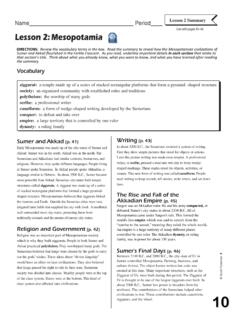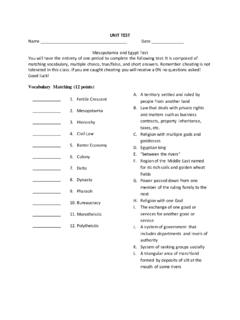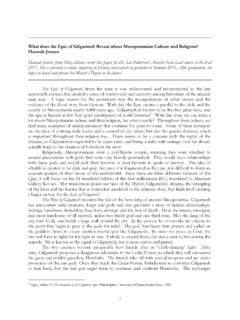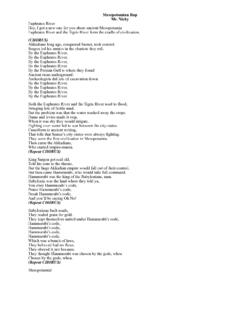Transcription of Mesopotamian Clothing - SDPBC Web CMS
1 10/19/2014 Student Resources in Context- Print1/4 Mesopotamian Clothing Fashion, Costume, and Culture, 2013 The civilizations that developed in mesopotamia near the Tigris and Euphrates Rivers between 3000 and developed impressive skills for fashioning Clothing . The evidence of these civilizations' Clothing remains onsculptures, pottery, and in writings left on tablets and royal tombs. It indicates that a thriving textile or fabricindustry existed in the early civilizations of mesopotamia , which included the Sumerians (3000 2000 ), theAkkadians (2350 2218 ), the Babylonians (1894 1595 ), the Assyrians (1380 612 ), and thePersians (550 330 ). Textiles were used for trade purposes and were also given as gifts to kings the earliest civilizations used animal skins to protect themselves from the environment, people soonlearned how to pound wool and goat hair into felt or weave it into cloth. Wool was the most common fabric usedto make Clothing in mesopotamia and was used for practically every type of garment from cloaks to for weaving fabric were in use as early as 3000 The skill of early weavers is extraordinary.
2 Somefragments of linen discovered in royal tombs are almost as finely woven as modern-day linen fabric. Linen was amore luxurious fabric and was woven for the Clothing of the wealthy, priests, and to adorn statues of gods. Otherfinely woven fabrics also became available for the wealthiest in mesopotamia . Soft cotton was introduced inAssyria around 700 , and silk became available surviving evidence does not show the colors of Clothing made in mesopotamia , but archeologists, scientistswho study past civilizations,10/19/2014 Student Resources in Context- Print2/4have discovered letters that describe how dyes, appliqu s, embroidery, and beads were used to beautifygarments. As early as 1200 a type of shell known as Maoris produced a highly prized dye called Tyrianpurple. Artifacts found in royal tombs provide evidence of fitted sewn garments, gold appliqu s, and elaboratelydecorated they woreThe earliest evidence of civilization in mesopotamia is identified as Sumerian.
3 Early Sumerian men typically worewaist strings or small loincloths that provided barely any coverage. However, later the wraparound skirt wasintroduced, which hung to the knee or lower and was held up by a thick, rounded belt that tied in the back. Theseskirts were typically decorated with fringe or pieces of fabric cut in a petal shape. All classes of men seem tohave worn these skirts. Early Sumerian women seem to have worn only a shawl wrapped around their shawls were often decorated with simple border patterns or allover patterns. Later Sumerian womentypically wore sewn outfits covered with tiers of fringe. These included skirts much like those worn by men andshawls or tops that were also fringed. By the end of Sumerian rule around 2000 both men and women woreskirts and is less evidence about what men and women wore during Babylonian rule from 1894 to 1595 Thescant evidence available suggests that Babylonians wore skirts and shawls very similar to the Sumerians,although some men during Babylonian rule did wear loin skirts with a hemline that slanted from the upper knee inthe front to the calf in the back.
4 Evidence does suggest that the fringe on garments became more elaborateduring this time. One painting discovered shows a king wearing a skirt with tiered fringe that is alternately coloredred, gray, gold, and white. No evidence of female attire exists except for pictures that depict goddesses. In theseillustrations, goddesses are shown wearing sleeved dresses with fitted bodices, V necks, and straight Assyrians, who ruled from 1380 to 612 , continued to wear fringed garments. Both men and womenwrapped fringed shawls over their shoulders and around their waists to cover themselves from their shoulders tonearly their ankles. These were held in place by belts. Around 1000 Assyrian men began wearing beltedknee-length tunics with short sleeves. Men of high status, such as kings and military officers, also wore woolencloaks dyed blue, red, purple, or white. After the Assyrians were conquered in 612 , the Persian Empirebegan to prosper and people in mesopotamia adopted Persian trousers into their More InformationHynson, Colin.
5 mesopotamia . Milwaukee, WI: World Almanac Library, 2006. Nemet-Nejat, Karen Rhea. DailyLife in Ancient mesopotamia . Westport, CT: Greenwood Press, , Blanche. History of Costume: From the Ancient Egyptians to the Twentieth Century. New York: Harperand Row, all the civilizations living in mesopotamia (the region centered in present-day Iraq near the Tigris andEuphrates Rivers) from 3000 to 300 , fringe was a popular and important decorative adornment for theclothing of both men and women. It is believed that fringe was worn by all classes of people. The evidence forhow fringe was used and what it looked like is found on sculptures, statues, and described in the writings left by10/19/2014 Student Resources in Context- Print3/4these adorned the two most basic garments worn in mesopotamia : the skirt and the shawl. These garmentswere made out of woven wool or linen, and later, for the wealthiest people, cotton or silk. The hems, or edges, ofskirts and shawls were decorated with fringe that either hung straight or was knotted into elaborate could be cut from the whole piece of cloth that made up the skirt or shawl or it could be a separate piecesewn onto the later civilizations of mesopotamia the fringe on garments became more and more decorative and could be dyed many colors and layered in tiers to cover entire garments.
6 Some men would use the fringeof their shawls as a type of signature for contracts. Instead of using a seal to impress their mark on a claycontract, men would use their unique fringe. Fringe has been used for decoration at other points in humanhistory, notably as decoration on the leather clothes of cowboys in the American West and as a brief fashiontrend in the ALSO Volume 5, 1961 79: FringeFor More InformationBancroft-Hunt, Norman. Living in Ancient mesopotamia . New York: Thalmus Publishing, , Karen Rhea. Daily Life in Ancient mesopotamia . Westport, CT: Greenwood Press, , Blanche. History of Costume: From the Ancient Egyptians to the Twentieth Century. New York: Harperand Row, the men and women living in mesopotamia (the region centered in present-day Iraq near the Tigris andEuphrates Rivers) from 3000 to 300 , a fringed shawl was a typical garment. Unlike modern-day shawls thatare worn over the shoulders and head, the shawls of mesopotamia were wrapped around the hips like long skirtsor wrapped around the torso with one end tossed over the left shoulder, covering the body to the feet like adress.
7 Whether worn as a skirt or a dress, shawls were held in place with belts tied in the first depictions of shawls on statues and bas-reliefs, or wall carvings, on the remains of palace walls showrather plain fabric wraps. In time, however, the fringe and decorative borders of these shawls became moreelaborate. Shawls were made most commonly out of wool, but wealthy people could afford finely woven linen,and after 700 , perhaps even cotton or silk. The wealthiest people also wore embroidered shawls or shawlsdecorated with gold or precious stone More InformationHollar, Sherman. mesopotamia . New York: Encyclopedia Britannica, Inc., 2012. Nemet-Nejat, Karen Rhea. DailyLife in Ancient mesopotamia . Westport, CT: Greenwood Press, Resources in Context- Print4/4 Payne, Blanche. History of Costume: From the Ancient Egyptians to the Twentieth Century. New York: Harperand Row, Text: COPYRIGHT 2013 Gale, Cengage Citation" Mesopotamian Clothing .
8 " Fashion, Costume, and Culture: Clothing , Headwear, BodyDecorations, and Footwear Through the Ages. Ed. Sara Pendergast, et al. 2nd 1: The Ancient World. Detroit: UXL, 2013. 55-59. Student Resources in 19 Oct. Document Number: GALE|CX2760000023









